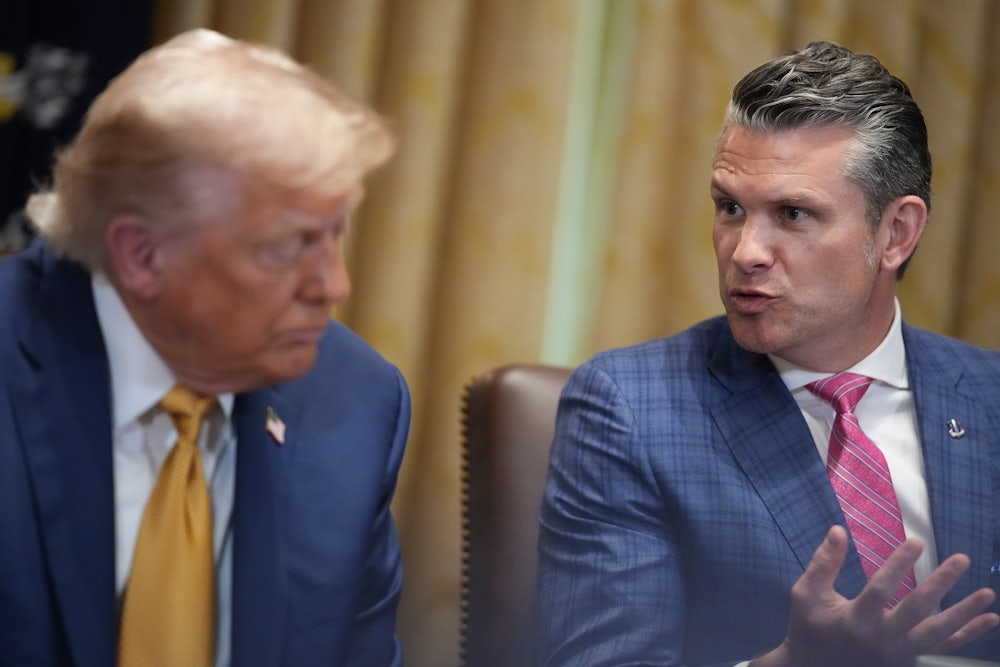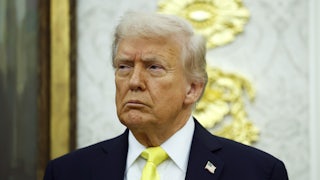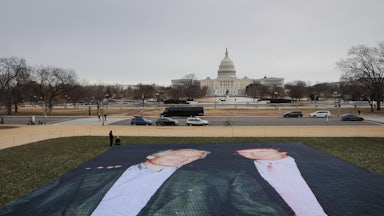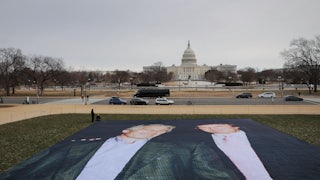President Donald Trump has already enmeshed the U.S. military in domestic law enforcement operations involving immigration to an unprecedented degree. He has authorized a major military buildup at the border. He has maximized the use of military planes for deportations, complete with the White House pumping out imagery of migrants getting frog-marched onto souped-up military aircraft. He sent the National Guard into Los Angeles amid large-scale protests there—and then sent in the Marines.
But an internal memo circulated inside the Department of Homeland Security suggests that Trump’s use of the military for domestic law enforcement on immigration could soon get worse. The memo—obtained by The New Republic—provides a glimpse into the thinking of top officials as they seek to involve the Defense Department more deeply in these domestic operations, and it has unnerved experts who believe it portends a frightening escalation.
The memo lays out the need to persuade top Pentagon officials to get much more serious about using the military to combat illegal immigration—and not just at the border. It suggests that DHS is anticipating many more uses of the military in urban centers, noting that L.A.-style operations may be needed “for years to come.” And it likens the threat posed by transnational gangs and cartels to having “Al Qaeda or ISIS cells and fighters operating freely inside America,” hinting at a ramped-up militarized posture inside the interior.
“The memo is alarming, because it speaks to the intent to use the military within the United States at a level not seen since Japanese internment,” Carrie Lee, senior fellow at the German Marshall Fund, told me. “The military is the most powerful, coercive tool our country has. We don’t want the military doing law enforcement. It absolutely undermines the rule of law.”
The memo was authored by Philip Hegseth—the younger brother of Defense Secretary Pete Hegseth—who is a senior adviser to Homeland Security Secretary Kristi Noem and DHS liaison officer to the Defense Department. As such, it also sheds light on Hegseth the Younger’s role, which has been the subject of media speculation labeling him an obscure but influential figure in his brother’s MAGA orbit.
The memo outlines the itinerary for a July 21 meeting between senior DHS and Pentagon officials, with the goal of better coordinating the agencies’ activities in “defense of the homeland.” It details goals that Philip Hegseth hopes to accomplish in the meeting and outlines points he wants DHS officials to impress on Pentagon attendees.
Participants listed comprise the very top levels of both agencies, including Defense Secretary Pete Hegseth and several of his top advisers, Joint Chiefs Chairman Dan Caine, and NORTHCOM Commander Gregory Guillot. Staff include Phil Hegseth and acting ICE Commissioner Todd Lyons.
“Due to the sensitive nature of the meeting, minimal written policy or background information can be provided in this briefing memo,” the memo says.
Lee of the German Marshall Fund told me this suggests “they understand that actions they’re taking are skirting the line.”
The primary goal of the meeting, the memo says, is to foster “new ideas for how the two departments can better plan for national security and illegal immigration.” Then it adds this:
The U.S. military leadership (the Chairman of the Joint Chiefs and NORTHCOM) need to feel—for the first time—the urgency of the homeland defense mission. They need to understand the threat, what’s at stake, and the political importance the administration has placed on this issue.
Experts I spoke with were surprised at how bluntly that suggests DHS pressure on the Defense Department to get the military much more involved in immigration enforcement, potential tension between top officials at both agencies over this imperative, and possible resistance to it by Pentagon officials. The memo says aligning both agencies this way “is a priority of POTUS,” meaning Trump.
“It’s disturbing to see DHS officials pressuring the U.S. military to turn its focus inward even further,” Joseph Nunn, counsel for the Liberty and National Security Program at the Brennan Center, told me. Nunn said this suggests “military involvement in domestic civilian law enforcement” is about to get “more common.”
The memo articulates the need for just that. It says that DHS hopes to secure “a verbal agreement to find places where DoD can detail personnel within ICE and [Customs and Border Protection] (and vice-versa) to increase information sharing, and specifically support nationwide operational planning capabilities.”
The upshot seems to be that DHS is urging top Pentagon officials to prioritize using the military against illegal immigration to a substantially greater and unprecedented degree, and that discussions are underway to accomplish that, with Defense Secretary Hegseth’s blessing.
“It sounds like DHS and Secretary Hegseth are trying to compel the military to agree to operate much more directly inside U.S. territory,” Kori Schake, director of foreign and defense policy studies at the American Enterprise Institute, told me.
Asked for clarification of the memo’s intentions, DHS spokesperson Tricia McLaughin declined comment. The New Republic obtained it on the condition that we refrain from posting the original document, so we posted much of the text of it here. We omitted some logistical and biographical details.
Then there’s the mention of Al Qaeda and ISIS. The memo details talking points for DHS officials to use to persuade these Pentagon officials to get more involved in domestic enforcement. It references attacks on DHS officers and Central and South American cartels and gangs, noting that they’ve been designated terrorist organizations.
“That puts this threat on the same plain [sic] as having Al Qaeda or ISIS cells and fighters operating freely inside America,” the memo says.
Experts I spoke with saw this line as particularly worrisome.
“The conflation of a low-level threat like transnational criminal organizations with Al Qaeda, which was actually attempting to topple the United States government, is a clear attempt to use excessive force for a purpose normally handled by civil authorities,” Lindsay Cohn, an associate professor at the U.S. Naval War College, told me.
The memo also discusses recent military operations in L.A as follows:
It hasn’t been perfect, and we’re still working through best practices together, but I think it’s a good indicator of the type of operations (and resistance) we’re going to be working through for years to come.
“That’s alarming, because it is putting responses to constitutionally protected protest in the same basket as counterterrorism and countering transnational criminal organizations,” Cohn said. “We do have legal ways for the military to support civilian law enforcement, but it’s always supposed to be a last resort. This memo is talking about turning internal homeland security into a regular Defense Department activity, which it is not. This is not normal.”
The larger context here is that the administration has taken extraordinary license in its invention of pretexts for draconian domestic operations. The administration has insisted we are under foreign “invasion” to invoke the 1798 Alien Enemies Act to deport hundreds of people with little to no due process. Government agencies have hyped supposed evidence of Kilmar Abrego Garcia’s MS-13 ties to justify illegally renditioning him to a Salvadoran prison. Trump has a long history of lying about crime to justify immigration crackdowns. He invented numerous fake pretexts for sending troops into L.A.
The memo suggests further operationalization of that tactic. “They see Los Angeles as a model to be replicated,” Lee said.
All this comes as ICE is about to receive well over $100 billion in new funds. The memo raises the question of what that use of military personnel detailed “within ICE and CBP” will look like with all that money.
In a sense, the administration seems to be supercharging immigration “invasion” agitprop to manufacture a sense of national trauma similar to the one that arose after the September 11 attacks. That led to another type of “war on terror” hyper-militarization at home (as well as abroad). The administration seems determined to outdo that—this time against the new internal enemy.
“Normalizing routine military support to law enforcement could create a kind of domestic ‘forever war,’ but one that is uniquely dangerous,” the Brennan Center’s Nunn told me. “As the Founders well understood, a military that is turned inward is a threat to both democracy and individual liberty.”






